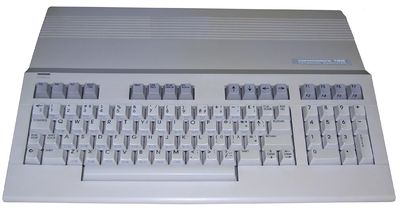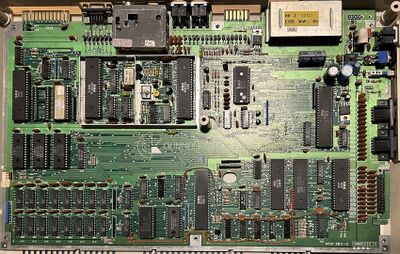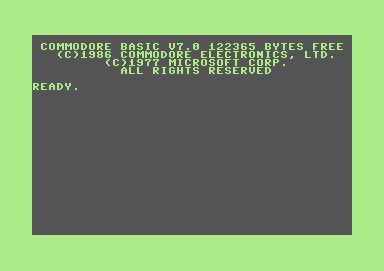Commodore 128
| Commodore 128 | |
 | |
| Type: | Home Computer |
| Producer: | Commodore |
| Price: | 300 US$ |
| Released: | 1985 |
| Discontinued: | 1989 |
| Processor: | |
| Memory: | 128 KByte, upgradeable |
| OS: |
|
| Info: | |
The C128 home computer (known as the Commodore 128, CBM 128, and C=128) was Commodore’s successor to the C64. It functioned as a dual home/office computer and was 99% compatible with existing C64 programs. It featured two processors: an MOS 6502 variant and a Z80. The Z80 enabled it to run the industry standard CP/M operating system and software. The C128 had more free working memory than the C64, a built-in reset button, a numeric keypad, a machine code monitor, and a higher display resolution.
The C128 has three modes:
- BASIC 7: available after turning on the C128
- BASIC 2: C64 mode, available after entering
GO64or holding down the C= key at startup - CP/M+ version 3.0: available after inserting and loading the CP/M system from disk drive
In 1986, Commodore introduced another model, the C128D, which integrated the C128 and 1571 floppy disk into a single desktop case. Both models will boot automatically from floppy disk. The C128D/C128DCR also featured a detachable desktop keyboard (all other C64/C128 models had a fixed keyboard).
Worldwide, Commodore sold around 4,500,000 units, with 284,300 units sold in Germany.
Construction[edit | edit source]
The C128 has following connectors, switches and interfaces:
Right side[edit | edit source]

- Game port (Control port) 1; 9 pin Sub-D connector for connecting a joystick, light pen, mouse or paddles
- Game port (Control port) 2; 9 pin Sub-D connector for connecting a joystick, mouse or paddles
- Reset switch
- Power on/off switch
- Power connector (Power; 5 pin angular) for the power supply)
Rear[edit | edit source]

- Main memory expansion (Expansion port; 44 pin; I/O) for connecting cartridges
- Cassette/Datasette port (Cassette port); 12 pin; I/O) for connecting a Datasette drive
- Serial bus interface or Serial Port (IEEE-488; 6 pin; I/O) for connecting disk drives or a printer
- Audio/Video connector (8 pin; I/O) for connecting a monitor/TV in 40 char mode,
- Antenna connector for connecting to TVs in 40 char mode (left of it: L-H for channel adjustment (optional)).
- RGBI connector (9 pin, output only) for connecting an RGB or monochrome monitor in 80 char mode.
- Userport (RS-232 or Centronics; 24 pin; I/O), which can be used by the C128 for connecting a modem or printer interface
Main board[edit | edit source]
- Processor: HMOSII 8502 with about 1.02 or 2.04 MHz memory clock, Z80B processor 4 MHz version with 2.04 MHz clocked
- Memory: 128 KByte RAM on two 64 KByte Chips (expandable internal on max. 256 KByte, external max. 640 KByte), from this are 38,911 or 122,365 Bytes free for use under BASIC
- Picture frequency memory VDC-8563 (16 KByte video RAM)
- Color memory 8564 (4×2 KByte)

- ROM: 64 KByte, split:
- C64 mode (16 KByte), Commodore BASIC V2.0 (8 KByte) and KERNAL (8 KByte)
- C128 mode (64 KByte), Commodore BASIC V7.0 (48 KByte in 2×16 KByte Chips), KERNAL (16 KByte) and C128 BIOS (16 KByte)
- CP/M BIOS (4 KByte)
- Special character set NMOS-ROM (8 KByte)
- Free connector for 32 KByte ROM (e.g. EPROM or additional character ROM)
- Video:
- The VIC-II or VIC-8564 for the 40 character mode has the ability for 25 (rows) × 40 (columns) characters (singlecolor and multicolor) in text mode (either big letters/graphic signs or big/small letters) or in graphic mode (HiRes) 320×200 pixel in 16 colors, 16 frame colors and 16 background colors or Multicolor mode (4 colors) 160×200 pixel, as well as 8 Sprites (singlecolor or multicolor, 24×21) displaying.
- VDC-8563 for 80 character mode 25 (rows) × 80 (columns) with 16 colors, 8 character attributes, 16 frame colors and 16 background colors in text mode (either big letters/graphic signs or big/small letters) or in graphic mode (HiRes) 640×200 pixel singlecolor or 640×400 interlaced

- Audio: SID 6581/8580
- Sound generator for three voices, 0-4 kHz
- 4 wave forms per generator (Sine, Triangle, Pulse, Noise)
- 3 amplitude modulators, 48dB
- 3 ADSR envelope generators
- Oscillator sync
- Ring modulation
- Programmable filters (low, band-pass, high-pass or notch filter)
- Random generator
- 2 connections for potentiometers
- Audio inputs
- Keyboard: 92 keys (QWERTY/QWERTZ), which are multiple reserved, with numeric keypad, German keyboard with DIN mode and
<ESCape>, <TAB>, <ALT>, <CAPS LOCK/ASCII+DIN>, <HELP>, <Line Feed>, <40/80-DISPLAY>, <NO SCROLL>, the Function buttons are predefined
- Miscellaneous: 2 CIA-6526 for the I/O control (Input/Output), IC for memory management MMU-8722
Function Keys[edit | edit source]
The C128/D/DCR function keys are normally:
- F1 GRAPHIC
- SHIFT +F2 DLOAD+CHR$(34)
- F3 DIRECTORY+CHR$(13) (the key RETURN is hit)
- SHIFT +F4 SCNCLR+CHR$(13)
- F5 DSAVE+CHR$(34)
- SHIFT +F6 RUN+CHR$(13)
- F7 LIST+CHR$(13)
- F8 MONITOR+CHR$(13)
An overview or a modify of the function keys follows through the BASIC-command KEY in direct mode or in programs. After a reset or a reboot are the normally function key configuration active.
Links[edit | edit source]
| Wikipedia: Commodore_128 |